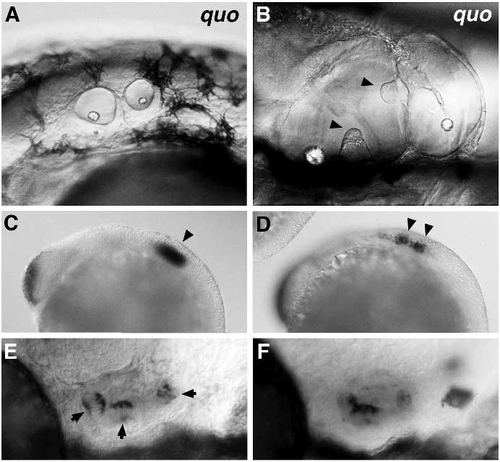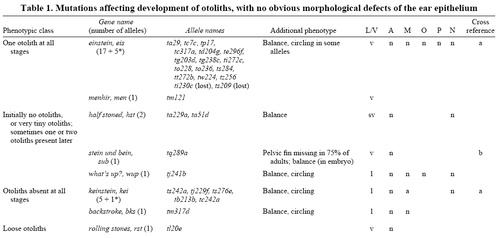- Title
-
Mutations affecting development of the zebrafish ear
- Authors
- Malicki, J., Schier, A.F., Solnica-Krezel, L., Stemple, D.L., Neuhauss, S.C., Stainier, D.Y., Abdelilah, S., Rangini, Z., Zwartkruis, F., and Driever, W.
- Source
- Full text @ Development
|
Ear development in wild-type zebrafish. (A) At 30 hpf the zebrafish ear is an epithelial vesicle containing two otoliths. (Arrowhead indicates the midbrainhindbrain boundary.) (B) Appearance of the zebrafish ear at approximately 60 hpf. Development of the semicircular canals is initiated by the appearance of epithelial protrusions (arrow) extending into the lumen of the otocyst. Protrusions growing from opposing walls of the otocyst fuse together forming columns surrounded by the lumen of semicircular canals. Formation of columns delimiting the anterior and posterior semicircular canals is well advanced at this stage. (C) At 5 dpf the semicircular canals are well formed and easily recognizable in a living embryo (arrows). (D) A schematic representation of the major morphological elements of the zebrafish ear accessible to visual inspection at 5 dpf (compare with photograph in C). The anterior (ac), posterior (pc) and ventral (vc) columns delimit the lumen of semicircular canals (arrows). The posterior otolith (po) is located behind the translucent, ventral column. ao, anterior otolith; asc, anterior semicircular canal; psc, posterior semicircular canal; lsc, lateral semicircular canal. Scale bar, 100 μm. |
|
The ear phenotype of quadro (quo)m271 mutants. In some mutant embryos the otocyst is split into two incomplete vesicles. A and B show the appearance of ears in the mutant at 36 hpf and 5 dpf respectively. Epithelial protrusions form but frequently do not develop into columns (arrowheads in B). At 14 hpf dlx-3 is expressed in the forming otic placode of wild-type embryos (arrowhead in C). In some mutant embryos, the dlx-3 expression domain is split into two smaller fields at this stage (arrowheads in D). In the wild-type ear the msx-C gene is expressed in three distinct patches at 60 hpf (arrows in E). The msx-C expression domains are frequently fused or absent in quom271 embryos at this stage (F). In all panels anterior is left and dorsal up. EXPRESSION / LABELING:
PHENOTYPE:
|
|
Phenotypes resulting from mutations affecting early morphogenesis of the otic vesicle. At 30 hpf the otic vesicles of (A) mind bomb (mib)m178; (B) snakehead (snk)m273; (C) pandora (pan)m313; and (D) flachland (fll)m517 mutants are of abnormal size and shape (compare with the wild type in Fig. 1A). Formation of otoliths is also affected in these mutants. Epithelial protrusions form in the otic vesicle of mibm178 at 60 hpf (arrowhead in E). At 60 hpf the otic vesicle of snkm273 frequently does not form protrusions and appears to be disproportionately large compared to other organs (F). Arrowheads in A-D indicate the midbrain-hindbrain boundary. In all panels anterior is left and dorsal up. |
|
Phenotypes involving absence of otoliths. (A) The morphology of semicircular canals is normal in empty ear (emp)m107 but the otoliths do not form. At 36 hpf the otic vesicle of helter skelter (hek)m504 larvae (C) appears to be larger than its wild-type counterpart (B). The ear of znikam (znk)m574 is smaller at 3 dpf than its wild-type equivalent and the otic capsule less distinct (D, compare with Fig. 5D). In some outcrosses ectopic otoliths form in the ears of haos (hos)m751 animals (arrowheads in E). In all panels anterior is left and dorsal up. A and E show larval ears at 5 dpf. |
|
The phenotypes of little richard (lit) and golas (gos) mutants. At 3 dpf the ear of litm433 (B,E) is markedly smaller than its wild-type counterpart (A,D). In the wild-type larva the semicircular canals are well developed at this stage (D). In contrast, formation of semicircular canals in litm433 mutants is not initiated (E). At 3 dpf the ear of gosm241 is smaller than its wild-type counterpart and has abnormal shape (C, compare with A). The gosm618 mutation produces a much more pronounced reduction of ear size (F, compare with the wild type in D). (G) Wild-type expression of msx-C at 60 hpf (arrows). (H) msx-C is not expressed in litm433 at 60 hpf. Arrowheads in A and B indicate positioning of the pectoral fin. In all panels anterior is left and dorsal up. EXPRESSION / LABELING:
PHENOTYPE:
|
|
The phenotype of antytalent (ant)m426 mutants at 5 dpf. (A) In the lateral view, the mutant otic capsule and semicircular canals are not easily recognizable at this stage. (B) In the dorsal view the anterior and posterior semicircular canals are clearly visible in the wild type. In contrast, the ear of antm426 mutants (C) is flattened and the semicircular canals are not distinct. The arrowheads in B and C indicate positioning of the otolith. In A dorsal is up. In all panels anterior is left. ac, anterior canal; pc, posterior canal. PHENOTYPE:
|

ZFIN is incorporating published figure images and captions as part of an ongoing project. Figures from some publications have not yet been curated, or are not available for display because of copyright restrictions. |
|
L/V: viability. l, lethal; v, viable; sv, semiviable. A, fluorescein-phalloidin stain for stereocilia of inner ear hair cells; M, mshC expression in ear at 48 hours; O, otx1 expression in ear at 24 or 48 hours; P, paxb expression in ear at 24 hours; N, neuromasts present (as seen under microscope or stained with DASPEI). n, normal; a, abnormal. A blank entry indicates ‘not done’. See text for details. The Cross reference column indicates descriptions of other aspects of the mutant phenotype: a, Malicki et al. (1996); b, van Eeden et al. (1996b). Total number of unresolved otolith mutations: 8: tf234, tg225, tg254c, th276, th279c, tn218d, to275b, tu242d. *Boston alleles: Malicki et al. (1996). Cross-complementation with ear mutants from the zebrafish screen in Boston has only been done so far for einstein and keinstein. |







